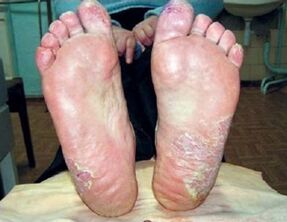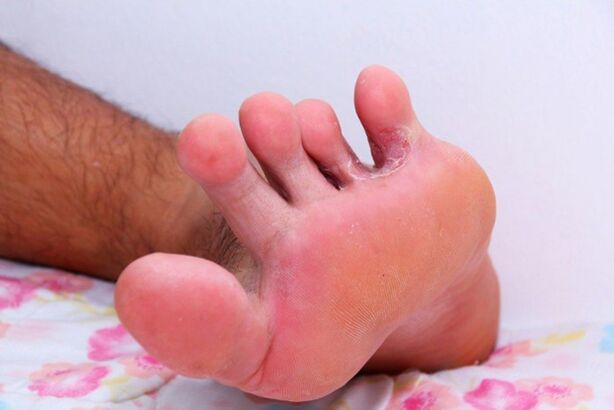Foot elasticity (mycosis) is a very common disease, the symptom of which is damage to the skin.
Infection occurs when healthy skin comes in contact with a spore carrier, as well as through household contact: through shoes, shared bathrooms and contaminated items. Fungal infection easily penetrates into the interdigital folds (under favorable conditions), where it begins to grow in its path and on the entire surface of the foot.

What is a mushroom?
Mycosis of the feet is the most common type of dermatomycosis characterized by chronic relapses. This includes damage to both the skin and the nails. There is a mass of fungi on the constantly peeling surface of the skin, as well as their spores.
Fungus is a contagious disease that is transmitted from person to person through household items. Interdigital folds are affected first, so itching appears. After that, the infection covers the entire area of the foot. The disease progresses rapidly and is characterized by itching, burning, pain, dry skin, peeling and even diaper rash.
Reasons for appearance
The main cause of the disease are microorganisms of the genus Trichophyton, as well as fungi. Dozens of infections occur under the following conditions:
- wear tight shoes (when the feet are squeezed, cracks and bed sores form where the infection can easily develop);
- excessive sweating of the legs (this is an excellent environment for the development of fungal populations);
- with high humidity in the room (shower, bathroom) - favorable conditions for all types of fungi;
- frequent visits to saunas, swimming pools (increased risk of contact with infectious agents);
- the presence of a sick person in the family (you can be infected through household items: slippers, socks and a common bath).
There are a number of diseases that a person is susceptible to fungal infections:
- immune deficiency (weakened immune system is more susceptible to infectious and bacterial diseases);
- taking hormonal drugs (violation of hormonal levels);
- flat feet (with this disease it is difficult to choose shoes with the right rise, often the legs are compressed);
- varicose veins (poor blood circulation causes dry skin);
- atherosclerosis;
- diabetes mellitus (increased capillary permeability, there is a change in their barrier function).
Symptoms

The main symptoms of foot mycosis are:
- burning and itching between the toes of the lower extremities (in the initial form) and on the entire surface of the feet (in later stages);
- painful sensations (of varying intensity: the pain may increase, then disappear completely in a short time);
- redness of the skin (slightly pink to purple);
- dryness and abundant peeling (separation of blacks and bark from boards);
- cracks in the skin of the feet (does not go with ordinary moisturizers);
- changes in the color and structure of nails (they thicken and wear);
- unpleasant foot odor (if not previously observed).
It is important!
With a fungal infection, the usual hygiene procedures (washing the feet, pumice and steaming) do not work, the symptoms do not pass!
Why treat fungi?

The success of therapy depends on the accuracy of the diagnosis and the identification of the exact type of causative agent of mycosis of the feet. Regardless of the form and stage of the fungal infection, an integrated approach is used in treatment.
Without a competent approach to treatment, the fungus will not go anywhere, it is not a spontaneous disease.
After all, the waste products of parasitic fungi will spread to the surrounding tissues, enter the bloodstream, poison it, and this is an allergen for the human body (eczema can even develop).
In addition, a person infected with a fungus is a source of infection and a danger to others. After all, the infection occurs through household items and contact with the skin of the carrier.
Mushroom forms
In general, there are 6 forms of this fungal lesion of the feet:
- Deleted form. This is the initial form, differing in the following manifestations: small superficial cracks in the interdigital folds that do not cause slight peeling and discomfort.
- Squamous form. Presence of small scales between the toes and on the surface of the heel. There are no signs of inflammation except for mild itching.
- Hyperkeratotic form. Appearance of blue-red plaques (papules) located on the arches of the feet. Dry skin, moderate pain and itching are noted.
- Intertriginous form. This is similar to a diaper rash. In the interdigital folds, the skin becomes bright red, swelling and weeping cracks appear, and even erosion may occur. Completes the picture of pain, burning and itching.
- Dyshidrotic form. The appearance of bubbles closed with a tight lid from above is noted. They are localized in the arches of the feet and are characterized by severe itching.
- Acute form. The skin of the feet is covered with purulent-serous vesicles and blisters, the opening of which causes numerous erosions and deep cracks. Body temperature rises significantly, the skin of the feet is bright red, there is severe pain, difficulty walking, headache and general weakness. Inguinal lymphadenitis develops.
Virus diagnostics
The diagnosis of the disease is made by a dermatologist or mycologist (it depends on the zone and degree of fungal infection) and is based on the detection of a fungus when examining the skin scales under a microscope.
The skin is removed from the injured part of the foot by scraping, and then treated with special reagents. During the microscopic examination, the specialist determines the type of pathogen or grows the fungus in a nutrient medium (it is easier to determine its type with a growing population).
Methods of treatment

The main rule in the treatment of mycoses of the legs is an integrated approach, which includes not only the use of drugs, alternative treatments, but also careful care of the affected skin.
Before starting drug therapy, you should consult a doctor who will determine the pathogen using laboratory tests. Mycosis of the foot should be treated under close medical supervision or in a hospital setting. Therapy is carried out in 2 stages: preparation and basic.
The first involves the elimination of inflammation, as well as the removal of the stratum corneum using the initial evaporation of the legs in a solution of potassium permanganate and boric acid.
The second stage involves drug treatment.
Drug treatment (ointments, creams, tablets, other drugs)
After removing the top keratinized cells, a special cream containing antibiotics and corticosteroid hormones is applied to the entire affected surface. After eliminating the inflammation, foot baths are canceled. The next treatment is the deep removal of the corneal layers using salicylic oil gel.
Apply a thin layer to the damaged area until the horn particles are completely separated. Therapy to boost immunity is also effective: taking immunomodulators and vitamin complexes, because the stronger the body's immune system, the faster the disease passes.
It is important!
It is forbidden to use ointments! They can cause crying erosion.
Treatment with folk remedies for this disease is not the main method of treatment, it can only be adjuvant therapy.
Folk remedies
Treatment should be systematic and include not only drugs, but also folk remedies:
- Apple cider vinegar is considered the best such recipe, because mushrooms do not like acidic environments. The method of application is very simple - apply a solution of vinegar to the affected area (concentration is selected individually), put on socks and lie down.
- Laundry soap and soda are another effective method. Grate 3 tablespoons of soap and add the same amount of soda. Pour this mixture with boiling water (at least 5 liters), put your feet down there for 15-20 minutes. After the procedure, clean the feet with a nail file or pumice stone.
- Significant results are also shown by glycerin with vodka. The bottle of glycerin should be filled to the brim with alcohol, shaken and moistened with this composition every day (before going to bed).
- Coffee is effective in combating mycosis. You need to brew strong coffee and immerse your feet in the drink until it cools down. It is recommended to do this procedure for at least a week.
- Celandine is also a good helper for fungal infections. Pour 1 liter of water into the kettle, put in the oven, bring to a boil and add 4 tbsp. l. herbs (boil for 5 minutes). In the resulting infusion, you should blow your feet for 3 weeks a day.

How to treat a fungus in a child?
Treatment of mycosis in children occurs in several stages:
- steam your feet (you can also use chamomile broth in a solution of soda and laundry soap or with the addition of apple cider vinegar - an excellent antiseptic);
- removal of keratinized particles (rub the crusty surface with a pumice stone or a rough washcloth until the upper layer of the epidermis is peeled off);
- treatment of the affected area with 2% iodine heals and disinfects well (you can apply iodine mesh on infected skin);
- Apply miconazole and nystatin-based creams before going to bed (they are safe and very effective for children) and wear cotton socks (or special antibacterial ones).
Disease prevention
Preventive measures are very simple and cover the following points:
- Follow the rules of personal hygiene (especially when visiting public pools, baths and saunas). It is necessary to move in shoes, not to be barefoot on the ground and not to wear someone else's shoes.
- During the visit, you should also refrain from wearing shoes and walk indoors in socks.
- Wash your feet every day before going to bed with antimicrobial soap and a towel.
- Be sure to dry your feet (especially between your toes) after washing.
- When keratinized cells appear, they should be treated with pumice stone and scissors or nippers.
- You need to cut your nails in time to prevent delamination.
- If you have cracks on the feet, you must use special gels and creams.
- Wearing narrow shoes is not allowed, as it disrupts blood circulation.
- In case of wounds and scratches on the skin of the feet, they should be treated with a bright green color.
- It is necessary to use special sprays and gels with increased sweating of the feet (not sold in any pharmacy).
The result
Mycosis of the feet is an insidious disease that not only causes discomfort and spoils the appearance of the skin and nails, but can also cause eczema, as well as reduced immunity. Basic hygiene standards must be followed to prevent fungal infections.
Well, in case of infection - avoid immediately to seek advice from a specialist who will diagnose and prescribe effective treatment. When treatment is started on time, it is easy to defeat the mycosis.
















